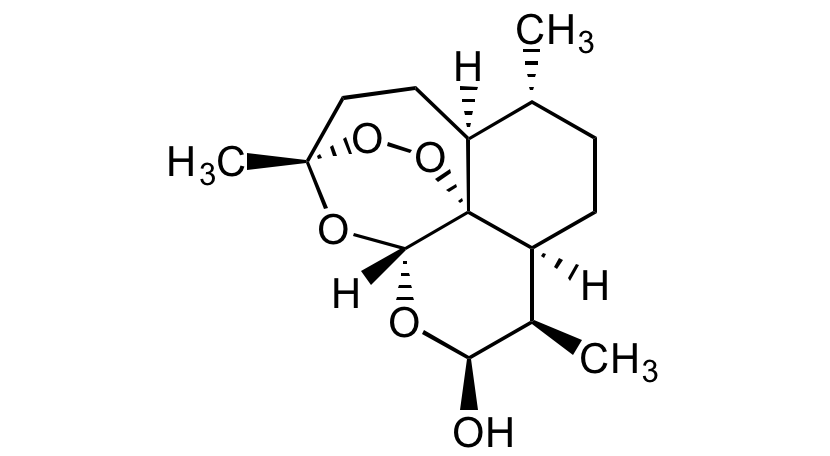Dihydroartemisinin
Product Code: AG-CN2-0468
Product Group: Natural Products and Extracts
Supplier: AdipoGen Life Sciences
| Code | Size | Price |
|---|
| AG-CN2-0468-M050 | 50 mg | £45.00 |
Quantity:
| AG-CN2-0468-M250 | 250 mg | £90.00 |
Quantity:
| AG-CN2-0468-G001 | 1 g | £150.00 |
Quantity:
Prices exclude any Taxes / VAT
Overview
Antibody Isotype: n/a
Antibody Clone: n/a
Regulatory Status: RUO
Shipping:
Ambient
Storage:
-20°C
Images
Documents
Further Information
Alternate Names/Synonyms:
Dihydroqinghaosu; Artenimol; DHA
Appearance:
White solid.
CAS:
71939-50-9
EClass:
32160000
Form (Short):
liquid
Handling Advice:
Keep cool and dry.Protect from light.Protect from moisture and oxygen.
InChi:
InChI=1S/C15H24O5/c1-8-4-5-11-9(2)12(16)17-13-15(11)10(8)6-7-14(3,18-13)19-20-15/h8-13,16H,4-7H2,1-3H3/t8-,9-,10+,11+,12+,13-,14-,15-/m1/s1
InChiKey:
BJDCWCLMFKKGEE-ISOSDAIHSA-N
Long Description:
Chemical. CAS: 71939-50-9. Formula: C15H24O5. MW: 284.3. Isolated from Artemisia annua. Active metabolite of artemisinin. Anti-malaria (Plasmodium). Anti-schistosoma. Apoptosis inducer. Anti-cancer. Anti-inflammatory Inhibits production of tumor necrosis factor-alpha (TNF-alpha), interleukin-6 (IL-6), monocyte chemotactic protein-1 (MCP-1) and nitric oxide (NO). Autophagy inducer.
MDL:
MFCD00274495
Molecular Formula:
C15H24O5
Molecular Weight:
284.3
Package Type:
Vial
Product Description:
Active metabolite of artemisinin. Anti-malaria (Plasmodium). Anti-schistosoma. Apoptosis inducer. Anti-cancer. Anti-inflammatory Inhibits production of tumor necrosis factor-alpha (TNF-alpha), interleukin-6 (IL-6), monocyte chemotactic protein-1 (MCP-1) and nitric oxide (NO). Autophagy inducer. Functional ARX inhibitor. Enhancer of GABAA signalling. Targets Gephyrin. Sown to have anti-SARS-CoV-2 activity with an EC50 of 13.31 ? 1.24µM, and beeing potentially useful in the treatment of COVID-19.
Purity:
>98% (HPLC)
SMILES:
[H][C@@]12CC[C@@H](C)[C@]3([H])CC[C@]4(C)OO[C@@]13[C@]([H])(O[C@H](O)[C@@H]2C)O4
Solubility Chemicals:
Soluble in DMSO or ethanol.
Source / Host:
Isolated from Artemisia annua.
Transportation:
Non-hazardous
UNSPSC Category:
Natural Products/Extracts
UNSPSC Number:
12352200
Use & Stability:
Stable for at least 1 year after receipt when stored at +4°C.
References
Qinghaosu (artemisinin): an antimalarial drug from China: D.L. Klayman; Science 228, 1049 (1985) | Comparison of in vivo and in vitro antimalarial activity of artemisinin, dihydroartemisinin and sodium artesunate in the Plasmodium berghei-rodent model: C. J. Janse, et al.; Int. J. Parasitol. 24, 589 (1994) | The development of the antimalarial drugs with new type of chemical structure--qinghaosu and dihydroqinghaosu: Y. Tu; SE Asian J. Trop. Med. Publ. Health 35, 250 (2004) | Artemisinin induces apoptosis in human cancer cells: N.P. Singh & H.C. Lai; Anticancer Res. 24, 2277 (2004) | Artemisinin attenuates lipopolysaccharide-stimulated proinflammatory responses by inhibiting NF-kappaB pathway in microglia cells: C. Zhu, et al.; PLoS One 7, e35125 (2012) | In vivo activity of dihydroartemisinin against Schistosoma mansoni schistosomula in mice: H.J. Li, et al.; SE Asian J. Trop. Med. Publ. Health 44, 379 (2013) | Differential effect of artemisinin against cancer cell lines: M. Tilaoui, et al.; Nat. Prod. Bioprospect. 4, 189 (2014) | Dihydroartemisinin supresses inflammation and fibrosis in bleomycine-induced pulmonary fibrosis in rats: D. Yang, et al.; Int. J. Clin. Exp. Pathol. 8, 1270 (2015) | Dihydroartemisinin increases temozolomide efficacy in glioma cells by inducing autophagy: Z.S. Zhang, et al.; Oncol. Lett. 10, 379 (2015) | Artemisinins target GABAA receptor signaling and impair alpha cell identity: J. Li, et al.; Cell 168, 86 (2017) | EXP1 is critical for nutrient uptake across the parasitophorous vacuole membrane of malaria parasites: P. Mes?n-Ram?rez, et al.; PLoS Biol. 17, e3000473 (2019) | Anti-SARS-CoV-2 Potential of Artemisinins In Vitro: R. Cao, et al.; ACS Infect. Dis. 6, 2524 (2020)
Related Products
| Product Name | Product Code | Supplier | Artemisinin | AG-CN2-0467 | AdipoGen Life Sciences | Summary Details | |||||||||||||||||||||||||||||||||||||||||||||||||||||||||||||||||||||||||||||||||||||||||||||
|---|---|---|---|---|---|---|---|---|---|---|---|---|---|---|---|---|---|---|---|---|---|---|---|---|---|---|---|---|---|---|---|---|---|---|---|---|---|---|---|---|---|---|---|---|---|---|---|---|---|---|---|---|---|---|---|---|---|---|---|---|---|---|---|---|---|---|---|---|---|---|---|---|---|---|---|---|---|---|---|---|---|---|---|---|---|---|---|---|---|---|---|---|---|---|---|---|---|---|---|
| Artesunate | AG-CN2-0469 | AdipoGen Life Sciences | Summary Details | ||||||||||||||||||||||||||||||||||||||||||||||||||||||||||||||||||||||||||||||||||||||||||||||||



